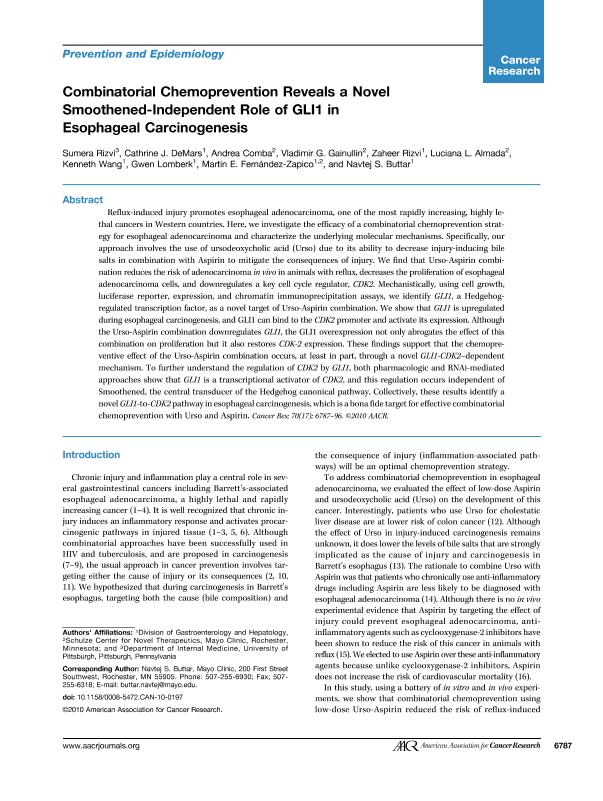Artículo
Combinatorial chemoprevention reveals a novel smoothened-independent role of GLI1 in esophageal carcinogenesis
Rizvi, Sumera; DeMars, Cathrine J.; Comba, Andrea ; Gainullin, Vladimir G.; Rizvi, Zaheer; Almada, Luciana L.; Wang, Kenneth; Lomberk, Gwen; Fernández-Zapico, Martin E.; Buttar, Navtej S.
; Gainullin, Vladimir G.; Rizvi, Zaheer; Almada, Luciana L.; Wang, Kenneth; Lomberk, Gwen; Fernández-Zapico, Martin E.; Buttar, Navtej S.
 ; Gainullin, Vladimir G.; Rizvi, Zaheer; Almada, Luciana L.; Wang, Kenneth; Lomberk, Gwen; Fernández-Zapico, Martin E.; Buttar, Navtej S.
; Gainullin, Vladimir G.; Rizvi, Zaheer; Almada, Luciana L.; Wang, Kenneth; Lomberk, Gwen; Fernández-Zapico, Martin E.; Buttar, Navtej S.
Fecha de publicación:
01/09/2010
Editorial:
American Association for Cancer Research
Revista:
Cancer Research
ISSN:
0008-5472
e-ISSN:
1538-7445
Idioma:
Inglés
Tipo de recurso:
Artículo publicado
Clasificación temática:
Resumen
Reflux-induced injury promotes esophageal adenocarcinoma, one of the most rapidly increasing, highly lethal cancers in Western countries. Here, we investigate the efficacy of a combinatorial chemoprevention strategy for esophageal adenocarcinoma and characterize the underlying molecular mechanisms. Specifically, our approach involves the use of ursodeoxycholic acid (Urso) due to its ability to decrease injury-inducing bile salts in combination with Aspirin to mitigate the consequences of injury. We find that Urso-Aspirin combination reduces the risk of adenocarcinoma in vivo in animals with reflux, decreases the proliferation of esophageal adenocarcinoma cells, and downregulates a key cell cycle regulator, CDK2. Mechanistically, using cell growth, luciferase reporter, expression, and chromatin immunoprecipitation assays, we identify GLI1, a Hedgehogregulated transcription factor, as a novel target of Urso-Aspirin combination. We show that GLI1 is upregulated during esophageal carcinogenesis, and GLI1 can bind to the CDK2 promoter and activate its expression. Although the Urso-Aspirin combination downregulates GLI1, the GLI1 overexpression not only abrogates the effect of this combination on proliferation but it also restores CDK-2 expression. These findings support that the chemopreventive effect of the Urso-Aspirin combination occurs, at least in part, through a novel GLI1-CDK2-dependent mechanism. To further understand the regulation of CDK2 by GLI1, both pharmacologic and RNAi-mediated approaches show that GLI1 is a transcriptional activator of CDK2, and this regulation occurs independent of Smoothened, the central transducer of the Hedgehog canonical pathway. Collectively, these results identify a novel GLI1-to-CDK2 pathway in esophageal carcinogenesis, which is a bona fide target for effective combinatorial chemoprevention with Urso and Aspirin.
Palabras clave:
GLI1
,
Hedgehog signaling
,
Chemoprevention
,
Esophageal adenocarcinoma
Archivos asociados
Licencia
Identificadores
Colecciones
Articulos(CCT - CORDOBA)
Articulos de CTRO.CIENTIFICO TECNOL.CONICET - CORDOBA
Articulos de CTRO.CIENTIFICO TECNOL.CONICET - CORDOBA
Citación
Rizvi, Sumera; DeMars, Cathrine J.; Comba, Andrea; Gainullin, Vladimir G.; Rizvi, Zaheer; et al.; Combinatorial chemoprevention reveals a novel smoothened-independent role of GLI1 in esophageal carcinogenesis; American Association for Cancer Research; Cancer Research; 70; 17; 1-9-2010; 6787-6796
Compartir
Altmétricas



